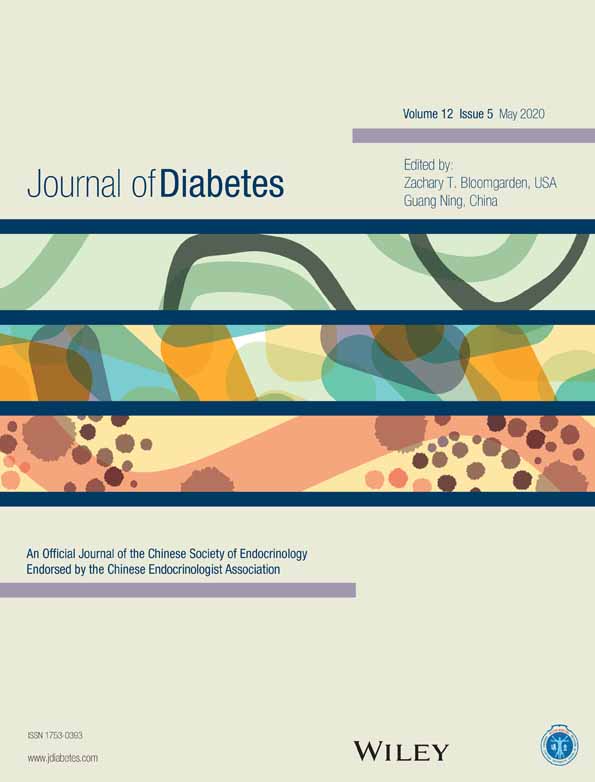The association of husbands’ smoking with wives' dysglycemia status: A cross-sectional study among over 10 million Chinese women aged 20-49
丈夫吸烟与妻子血糖异常状态的关联:一项基于1000万名20-49岁中国妇女的横断面研究
Funding information: The National Key Research and Development Program of China, Grant/Award Number: 2016YFC1000307; CAMS Innovation Fund for Medical Sciences, Grant/Award Number: 2018-I2M-1-004
Abstract
enBackground
We comprehensively evaluated the association between husbands’ smoking amount and wives' dysglycemia status.
Methods
We conducted a cross-sectional study which recruited 12 023 714 reproductive couples who participated in the National Free Pre-Pregnancy Checkups Project (NFPCP) between 2015 and 2016 in China. Multivariable logistic models were used to estimate odds ratio (OR) and 95% CI. Subgroup analysis and stratified analysis were further performed to investigate potential effect modification.
Results
Compared to the neither-smoker group, the multivariable-adjusted ORs for diabetes mellitus (DM) among women was 1.09 (95% CI, 1.07-1.10), 1.04 (95% CI, 0.87-1.23), and 1.28 (95% CI, 1.17-1.41) in the husband-smoker, wife-smoker, and both-smokers groups, respectively. An increased risk of DM was also observed for women whose husbands smoke 1 to 10 (OR, 1.06; 95% CI, 1.04-1.07), 11 to 20 (OR, 1.13; 95% CI, 1.11-1.15), and over 20 cigarettes per day (OR, 1.25; 95% CI, 1.17-1.31). The prevalence of wives' DM showed significant linear trends with husbands’ smoking amount (Pfor trend < .001). A similar growth tendency was also observed between husband smoking amount and impaired fasting glucose (IFG) prevalence with ORs of 1.04 (95% CI, 1.04-1.05), 1.05 (95% CI, 1.04-1.06), and 1.09 (95% CI, 1.06-1.11) for 1-10, 11-20, and over 20 cigarettes per day, respectively. The relationship between husbands’ smoking amount and wives’ IFG/DM prevalence appear to be modified by body mass index (BMI).
Conclusions
This study shows significant relationships between husbands’ smoking and wives' risk of IFG/DM, and this result exists in both a categorical and dose-response manner. This association is modified by BMI. Family-oriented smoking interventions may both reduce husbands’ active smoking and wives’ risk of DM.
摘要
zh背景
研究全面综合评估了丈夫吸烟与妻子血糖异常状态的关联性。
方法
本研究采用横断面研究设计的方法, 选取在2015 至2016年期间参加全国免费孕前优生健康检查项目的12,023,714对备孕夫妇作为研究对象。采用多因素Logistic回归模型估计丈夫吸烟的相对危险度(Odds Ratio, OR)和95%置信区间(95% CI)。同时采用亚组分析和分层分析进一步探索潜在的修饰效应。
结果
与丈夫和妻子均不吸烟组相比, 丈夫吸烟组、妻子吸烟组以及丈夫妻子均吸烟组中妻子糖尿病的患病率均较高, 经多因素校正后, 其OR值分别为1.09 (95% CI, 1.07-1.10), 1.04 (95% CI, 0.87-1.23)和1.28 (95% CI, 1.17-1.41)。在所有妻子自身不吸烟的家庭中, 以丈夫不吸烟的妻子为参照组, 丈夫吸烟支数为1-10支/天, 11-20支/天, >20支/天组的妻子患糖尿病的风险随着丈夫每日吸烟支数的增加而增加, OR值分别为1.06(95% CI, 1.04-1.07), 1.13(95% CI, 1.11-1.15)和1.25(95% CI, 1.17-1.31)。妻子的糖尿病患病率与丈夫的吸烟量呈显著线性相关关系(Pfor trend< .001)。丈夫吸烟量与妻子空腹血糖受损患病率之间也存在类似的升高趋势, 与丈夫不吸烟的妻子相比, 丈夫吸烟支数为1-10支/天, 11-20支/天, >20支/天组的妻子其患空腹血糖受损的风险为1.04(95% CI, 1.04-1.05), 1.05 (95% CI, 1.04-1.06), 和 1.09 (95% CI, 1.06-1.11)。此外, 本研究还发现女性身体体重指数(BMI)对丈夫吸烟与妻子空腹血糖受损/糖尿病之间的关联关系存在效应修饰的作用。
结论
本研究表明丈夫吸烟与妻子空腹血糖受损及糖尿病的患病风险之间存在显著的关联关系, 且存在显著的剂量效应关系。女性BMI可对丈夫吸烟及妻子空腹血糖受损及糖尿病的患病风险起到效应修饰的作用。以家庭为导向的吸烟干预不仅可以减少丈夫的主动吸烟造成的自身健康损害, 还可降低妻子患糖尿病的风险。




